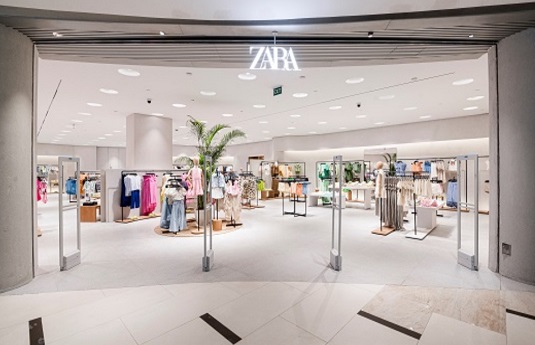
- Store Count: 6,500 stores in 88 countries
- Parent Company: Inditex
- India Launch: 2010, under Inditex SA, a joint venture with Trent Ltd, the retail arm of the Tata Group.
- India Presence: Zara currently operates 21 stores across 11 cities in India
About the Company
With around 6,500 stores spanning across 88 countries, Zara, today, is by default one of the largest international retailers of fast-fashion. The company’s USP is to offer fast fashion clothing products at pocket-friendly prices.
Started in 1975 by Amanico Ortega in Spain, the inspiration for Zara was found after he had established his first dressmaking factory in 1963 under the name Inditex. The success of his initial foundation led him to envision a brand that went on to become path-breaking.
Zara now operates out of 88 countries with over 2,200 stores. The fashion group also owns brands such as Pull&Bear, Massimo Dutti, Bershka, Stradivarius, Oysho, Zara Home and Uterqüe. READ MORE HERE
India Presence
Zara was launched in India in 2010 by Inditex Trent Retail India Private Ltd (ITRIPL), a joint venture with Trent Ltd, the retail arm of the Tata Group. The Inditex Group owns 51 per cent while Trent has 49 per cent in ITRIPL.
In spite of not opening any new stores recently, the company is still seeing good days when it comes to profit-making in India. Inditex, in a report said that Zara in 2022 made a net profit of Rs 148.76 crore and revenue of Rs 1,815 crore, by March 31 2022 in India.
Although Zara reported a net loss of Rs 41 crore in FY21 due to the pandemic, the company made a quick recovery later that year. RBC analyst Richard Chamberlain said in a research note that Zara is set to benefit from its competitive prices even amid some supply chain issues because its ‘rapid output of new fashion lines’ will always work in its benefit.
The brand today is highly popular among the Indian youth and influencers alike, who add to the company’s growth.
Globally Renowned
One of the common reasons with regards to Zara’s increasing popularity is that it has become a label that is impossible to miss. This is primarily because of Ortega’s vision to use his company’s accumulated revenues to aid Zara’s global expansion rather than investing the same revenue towards its marketing and advertising. The store is now found in high streets and malls of multiple countries.
Since its inception, Zara now operates in Mexico (1992), Greece, Belgium and Sweden (1993). In the early 2000s, Zara opened its first stores in Japan and Singapore (2002), Russia and Malaysia (2003),China, Morocco, Estonia, Hungary and Romania (2004), the Philippines, Costa Rica and Indonesia (2005), South Korea (2008), India (2010),and South Africa and Australia (2011). In all, Zara’s high popularity and increasing brand visibility comes from its rapid expansion and growth.
Unique Company Policy
Companies that think out of the box make it big. Zara has a strict no-marketing policy and its design, price point and store aesthetics speak for itself. The company has unique ways in which its core image is strategized to reach its target audience.
Prominent fashion retailers are highly prone to spending astronomical amounts on marketing and advertising with hopes to create an image that is unique and lasting, and that sets them apart from the rest.
But to make up for the high costs of their billboard or televised ads, fees charged by models and several other mediating factors, the products sold by them are bound to be priced higher than a brand that does not resort to such high-end marketing strategies.
Choosing to opt out of any kind of marketing was a big risk for the brand, but it was a decision that has not only set Zara apart from its fast-fashion competitors, but one that also enabled it to carve a unique niche in its area of expertise.
Most of Zara’s marketing takes places through a well-planned process of where exactly its experts choose to position its physical store. Zara’s stores are more often than not found right next to verified luxury brands like Gucci, Chanel or Massimo Dutti. This creates an illusion of it being a high-end luxury brand when in reality it is not.
On the contrary, Zara thrives by selling products and fabrics at mid-range prices that look and feel like luxury. It also sells low-priced lookalike products of high-end brands, which opens doors to large customer base. This consists mainly of people who want to experience luxury wear reasonably.
Keeping Up With Trends
Zara has a value chain that is vertically integrated and is something that offers many advantages. It is able to react quickly to market changes while also having high control over the entire process from design to final product.
One of Zara’s key strategies to always keep its stock fresh and trendy is to manufacture and dispatch products within a wide geographical area in a very short time. Their products are also made in a limited edition capacity, keeping in mind the specific market demand. These products are designed to sell within a short period so that they can be sold at full price, which also avoids the situation where the company is left with more old stock. Instead, it makes room for new fashion trends every week.
Sustainability
Making room for sustainability within a brand’s ethos is extremely important in today’s day. It helps with taking a step towards climate consciousness and also invites end consumers to be part of a meaningful journey with the brand.
Zara has been working to integrate sustainability into their everyday decision-making in order to have a positive impact on people and to reduce their environmental footprint. Their sustainability department continuously collaborates with all areas of the company to establish strategic lines of action and develop specific projects and set objectives.
Initiatives
- Zara’s Join Life label, first introduced in 2015, represents their approach to sustainability and showcases their continuous improvements across all verticals.
- In 2022, more than 50% of their collection was made in accordance with their Joint Life label requirements. Which means, above 50% of their collection was ‘more’ sustainable.
- This label makes use of the most environmentally-friendly products, which includes organic cotton, recycled polyester, or Tencel, which is a fabric made from wood.
Goals and Achievements
Circularity
- Zara aims to implement a fully circular economy model. This is a way of keeping resources in a circle of being reused, recycled and remanufactured.
- They also aim to create a system of technological innovation where any kind of textile waste in the future could become new fabric. This will enable products to be reintroduced into the production chain and minimize waste.
- In 2020, Zara created the Sustainability Innovation Hub, a platform to identify and test new technologies, materials and processes with the purpose of scaling them for their supply chain and the wider textile industry.
- Through the Zara Pre-Owned platform, the company also tries to extend the life of their products usefully. This initiative also adds on to their circular economy model.
Biodiversity
- Zara is working towards a more sustainable management of natural resources and biodiversity. Their ongoing project to support this includes sustainable cultivation techniques that help reduce the impacts of natural fibers like cotton.
- Currently, they are collaborating with their suppliers and different organizations such as Canopy, to secure fibers derived from forests.
- In 2014, Zara introduced its Forest Products Policy that ensures that all the paper and wood used to make everything, right from the packaging to store furnishings, have come exclusively from forests that are managed in a more sustainable way.
- They have partnered with The Fashion Pact and The Leaf Coalition to develop programs that minimize their impact on the ecosystem.
Animal Welfare
- Their animal welfare policy includes standards for the pursuit of ethical and responsible treatment of animals.
- The company only uses skins from animal that comes as a by-product of the food industry and avoid using muelsed wool, which is harmful for the animal.
- In line with their commitments to PETA and The Fur Free Alliance, Zara does not bring to market any fur products that might put the animal’s life at risk.
Water
- Zara’s supply chain development program for water, allows them to work continuously on minimizing the impacts of the wet processes necessary to manufacture their products, such as dyeing or washing.
- They aim to reduce 25% of the water impact in their supply chain by 2025.
- So far, they have worked with suppliers to ensure zero discharge of chemicals.
- They have an ongoing project to reduce water in the activity generated in stores, offices and logistics centers.
Energy
- Zara has a target of net zero emissions by 2040.
- 100% of the electrical energy that they use at their facilities comes from renewable sources.
- They have measures in place that aim to reduce emissions in their supply chain.
- They are currently developing measures to reduce emissions from transport.








